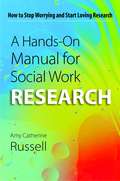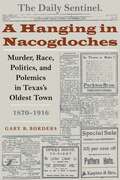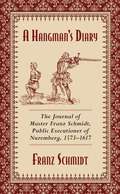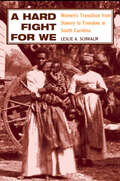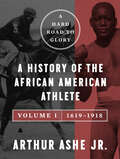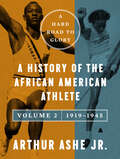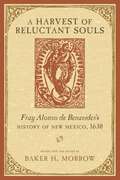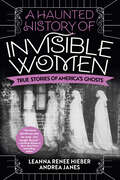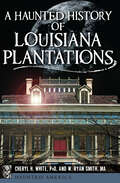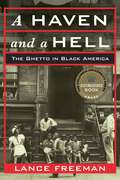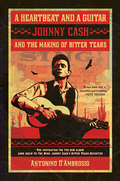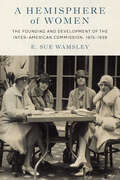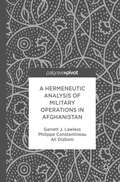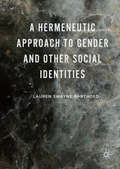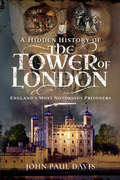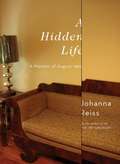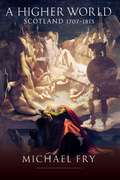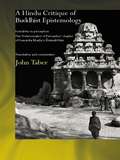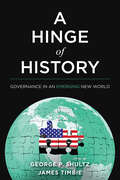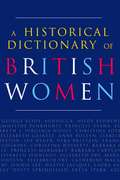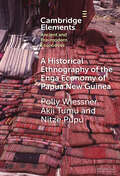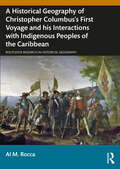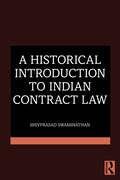- Table View
- List View
A Hands-on Manual For Social Work Research: How To Stop Worrying And Start Loving Research
by Amy Catherine RussellA hands-on approach to teaching research that overcomes the resistance of the most apprehensive student.
A Hanging in Nacogdoches: Murder, Race, Politics, and Polemics in Texas's Oldest Town, 1870-1916
by Gary B. BordersOn October 17, 1902, in Nacogdoches, Texas, a black man named James Buchanan was tried without representation, condemned, and executed for the murder of a white family--all in the course of three hours.<P><P> Two white men played pivotal roles in these events: Bill Haltom, a leading local Democrat and the editor of the Nacogdoches Sentinel, who condemned lynching but defended lynch mobs, and A. J. Spradley, a Populist sheriff who, with the aid of hundreds of state militiamen, barely managed to keep the mob from burning Buchanan alive, only to escort him to the gallows following his abbreviated trial. Each man's story serves to illuminate a part of the path that led to the terrible parody of justice which lies at the heart of A Hanging in Nacogdoches.
A Hanging in Nacogdoches: Murder, Race, Politics, and Polemics in Texas's Oldest Town, 1870–1916
by Gary B. Borders“The contribution of A Hanging in Nacogdoches is not limited to that city, East Texas, or even the state. . . . The purpose of the author's presentation is to show life-race relations, politics, the economy-in a typical . . . Southern town at the transition from the nineteenth to the twentieth century. Borders argues, and demonstrates, that Nacogdoches was, indeed, typical for its time and place.”-Archie P. McDonald, Regent's Professor of History, Stephen F. Austin State UniversityOn October 17, 1902, in Nacogdoches, Texas, a black man named James Buchanan was tried without representation, condemned, and executed for the murder of a white family-all in the course of three hours. Two white men played pivotal roles in these events: Bill Haltom, a leading local Democrat and the editor of the Nacogdoches Sentinel, who condemned lynching but defended lynch mobs, and A. J. Spradley, a Populist sheriff who, with the aid of hundreds of state militiamen, barely managed to keep the mob from burning Buchanan alive, only to escort him to the gallows following his abbreviated trial. Each man's story serves to illuminate a part of the path that led to the terrible parody of justice which lies at the heart of A Hanging in Nacogdoches. The turn of the twentieth century was a time of dramatic change for the people of East Texas. Frightened by the Populist Party's attempts to unite poor blacks and whites in a struggle for economic justice, white Democrats defended their power base by exploiting racial tensions in a battle that ultimately resulted in the complete disenfranchisement of the black population of East Texas. In telling the story of a single lynching, Gary Borders dramatically illustrates the way politics and race combined to bring horrific violence to small southern towns like Nacogdoches.
A Hangman's Diary
by Franz Schmidt<P> From 1573 to 1617, Master Franz Schmidt was the executioner for the towns of Bamberg and Nuremberg. During that span, he personally executed more than 350 people while keeping a journal throughout his career. <P> A Hangman's Diary is not only a collection of detailed writings by Schmidt about his work, but also an account of criminal procedure in Germany during the Middle Ages. With analysis and explanation, editor Albrecht Keller and translators C. Calvert and A. W. Gruner have put together a masterful tome that sets the scene of execution day and puts you in Master Franz Schmidt's shoes as he does his duty for his country. <P> Originally published more than eighty years ago, A Hangman's Diary gives a year-by-year breakdown on all of Master Schmidt's executions, which include hangings, beheadings, and other methods of murder, as well as explanations of each crime and the reason for the punishment. An incredible classic, A Hangman's Diary is more than a history lesson; it shows the true anarchy that inhabited our world only a few hundred years ago.
A Hard Fight for We: Women's Transition from Slavery to Freedom in South Carolina (Women, Gender, and Sexuality in American History)
by Leslie A. SchwalmAfrican-American women fought for their freedom with courage and vigor during and after the Civil War. Leslie Schwalm explores the vital roles of enslaved and formerly enslaved women on the rice plantations of lowcountry South Carolina, both in antebellum plantation life and in the wartime collapse of slavery. From there, she chronicles their efforts as freedwomen to recover from the impact of the war while redefining their lives and labor. Freedwomen asserted their own ideas of what freedom meant and insisted on important changes in the work they performed both for white employers and in their own homes. As Schwalm shows, these women rejected the most unpleasant or demeaning tasks, guarded the prerogatives they gained under the South's slave economy, and defended their hard-won freedoms against unwanted intervention by Northern whites and the efforts of former owners to restore slavery's social and economic relations during Reconstruction. A bold challenge to entrenched notions, A Hard Fight for We places African American women at the center of the South's transition from a slave society.
A Hard Road to Glory, Volume 1 (1619-1918): A History of the African-American Athlete
by Arthur Ashe Jr.With a Foreword by Jeanne Moutoussamy-AsheAvailable once again for a new generation of readers, the first volume in Arthur Ashe’s epic trilogy that chronicles the remarkable legacy of Black athletes in the United States—a major addition to our understanding of American history and the fulfillment of this legendary sports star and global activist’s lifelong dream.When tennis great Arthur Ashe first published his A Hard Road to Glory trilogy, this ambitious project—recognizing the contributions of Black athletes to American sports and culture—was the first of its kind, a milestone in the presentation of United States social history.Ashe had long believed that Black people needed to know their cultural history. But while teaching a seminar on the history of African American athletes at Florida Memorial College in 1981, he realized there was a vast amount of material about Black achievement that had never been collected, analyzed, and interpreted. To help to fill the gap, he began with the subject he knew best: sports.A Hard Road to Glory Volume 1 covers the period from 1619, when enslaved Africans were first brought to American shores, to 1918, the end of the First World War. Ashe reveals that from 1865 through 1896, Black Americans succeeded spectacularly in sports, witnessing accomplishments of athletes like Jack Johnson, the first Black heavyweight champion; Marshall Taylor, “the world's fastest cyclist;” and Isaac Murphy, a Hall of Fame jockey and the first three-time winner of the Kentucky Derby.In 2021, Black athletes and Black women in particular are receiving more visibility than ever for their unparalleled, world record-breaking excellence, their activism, and their leadership and vision. Serena Williams, Simone Biles, Sha’Carri Richardson, and Naomi Osaka are consistently elevating athletics and are reshaping the way we think about sports, excellence, society, and history.Arthur Ashe paved the way for them all; A Hard Road to Glory is fundamental to our understanding of Black athletes and our nation’s past, present, and future. Now more than ever, this collection is one of this amazing icon’s greatest legacies—a treasure to be celebrated by readers today and those to come.
A Hard Road to Glory, Volume 2 (1919-1945): A History of the African-American Athlete
by Arthur Ashe Jr.“The most comprehensive reference source on African-American athletes yet compiled.”—San Francisco ChronicleWith a Foreword by Jeanne Moutoussamy-AsheAvailable once again for a new generation of readers, the second volume in Arthur Ashe’s epic trilogy that chronicles the remarkable legacy of Black athletes in the United States—a major addition to our understanding of American history and the fulfillment of this legendary sports star and global activist’s lifelong dream.When tennis great Arthur Ashe first published his A Hard Road to Glory trilogy, this ambitious project was the first of its kind, a milestone in the presentation of United States social history. A Hard Road to Glory Volume 2, carries on the little-known full story of Black athletes and their contributions to American sports and culture. Volume 2 covers America’s “Golden Age” of sports from the end of World War One to the end of World War Two, from to 1919–1945. It was a time when the feats of legends such as Babe Ruth, Red Grange, and Jack Dempsey shone brightly—and segregation reigned supreme. Racial restrictions led to the formation of independent Black organizations, which saw its own share of extraordinary stars. Meanwhile, a number of great Black athletes, including Jesse Owens and Joe Louis, became sports heroes admired by millions worldwide.Today, Black athletes and Black women in particular are receiving more visibility than ever for their unparalleled, world record-breaking excellence, their activism, and their leadership and vision. Serena Williams, Simone Biles, Sha’Carri Richardson, and Naomi Osaka are consistently elevating athletics and are reshaping the way we think about sports, excellence, society, and history.Arthur Ashe paved the way for them all; A Hard Road to Glory is fundamental to our understanding of Black athletes and our nation’s past, present, and future. Now more than ever, this collection is one of this amazing icon’s greatest legacies—a treasure to be celebrated by readers today and those to come.
A Harvest of Reluctant Souls: Fray Alonso de Benavides's History of New Mexico, 1630
by Baker H. MorrowThe most thorough account ever written of southwestern life in the early seventeenth century, this engaging book was first published in 1630 as an official report to the king of Spain by Fray Alonso de Benavides, a Portuguese Franciscan who was the third head of the mission churches of New Mexico. In 1625, Father Benavides and his party traveled north from Mexico City to New Mexico, a strange land of frozen rivers, Indian citadels, and mines full of silver and garnets. Benavides and his Franciscan brothers built schools, erected churches, engineered peace treaties, and were said to perform miracles.Benavides&’s riveting exploration narrative provides portraits of the Pueblo Indians, the Apaches, and the Navajos at a time of fundamental change. It also gives us the first full picture of European colonial life in the southern Rockies, the southwestern deserts, and the Great Plains, along with an account of mission architecture and mission life and a unique evocation of faith in the wilderness.
A Haunted History of Invisible Women: True Stories of America's Ghosts
by Leanna Renee Hieber Andrea Janes"Deliciously eerie.&” —Leslie Rule, Bestselling AuthorFrom the notorious Lizzie Borden to the innumerable, haunted rooms of Sarah Winchester's mysterious mansion this offbeat, insightful, first-ever book of its kind from the brilliant guides behind &“Boroughs of the Dead,&” featured on NPR.org, The New York Times, and Jezebel, explores the history behind America&’s female ghosts, the stereotypes, myths, and paranormal tales that swirl around them, what their stories reveal about us—and why they haunt us . . . Sorrowful widows, vengeful jezebels, innocent maidens, wronged lovers, former slaves, even the occasional axe-murderess—America&’s female ghosts differ widely in background, class, and circumstance. Yet one thing unites them: their ability to instill fascination and fear, long after their deaths. Here are the full stories behind some of the best-known among them, as well as the lesser-known—though no less powerful . . . Tales whispered in darkness often divulge more about the teller than the subject. America&’s most famous female ghosts, from &‘Mrs. Spencer&’ who haunted Joan Rivers&’ New York apartment to Bridget Bishop, the first person executed during the Salem witchcraft trials, mirror each era&’s fears and prejudices. Yet through urban legends and campfire stories, even ghosts like the nameless hard-working women lost in the infamous Triangle Shirtwaist Factory fire —achieve a measure of power and agency in death, in ways unavailable to them as living women. Riveting for skeptics and believers alike, with humor, curiosity, and expertise, A Haunted History of Invisible Women offers a unique lens on the significant role these ghostly legends play both within the spook-seeking corners of our minds and in the consciousness of a nation. Afterword by Bram Stoker Award-winning author Linda D. Addison&“An absolute must-buy for the spooky people of the world . . . utterly brilliant.&” —Mallory O'Meara, bestselling author of The Lady from the Black Lagoon and Girly Drinks&“If this book doesn&’t leave with you a sense of wonder and a healthy dose of goosebumps, check your pulse—you may already be among the spirits.&” —Marc Hartzman, author of Chasing Ghosts: A Tour of Our Fascination with Spirits and the Supernatural
A Haunted History of Louisiana Plantations (Haunted America)
by Cheryl H. White W. Ryan SmithStories of ghosts and strange happenings at these historic Southern homes—with photos included. Louisiana plantations evoke images of grandeur and elegance, but beyond the facade of stately homes are stories of hope and subjugation, tragedy and suffering, shame and perseverance and war and conquest. After sixteen workers axed most of the Houmas House&’s ancient oak trees, referred to as &“the Gentlemen,&” eight of the surviving trees eerily twisted overnight in grief over the losses wrought by a great Mississippi River flood. An illegal duel to reclaim lost honor left the grounds of Natchez&’s Cherokee Plantation bloodstained, but the victim&’s spirit may still wander there today. A mutilated slave girl named Chloe still haunts the halls of the Myrtles Plantation in St. Francisville. In this book, Cheryl H. White and W. Ryan Smith reveal the dark history, folklore, and lasting human cost of Louisiana plantation life.
A Haven and a Hell: The Ghetto in Black America
by Lance FreemanThe black ghetto is thought of as a place of urban decay and social disarray. Like the historical ghetto of Venice, it is perceived as a space of confinement, one imposed on black America by whites. It is the home of a marginalized underclass and a sign of the depth of American segregation. Yet while black urban neighborhoods have suffered from institutional racism and economic neglect, they have also been places of refuge and community.In A Haven and a Hell, Lance Freeman examines how the ghetto shaped black America and black America shaped the ghetto. Freeman traces the evolving role of predominantly black neighborhoods in northern cities from the late nineteenth century through the present day. At times, the ghetto promised the freedom to build black social institutions and political power. At others, it suppressed and further stigmatized African Americans. Freeman reveals the forces that caused the ghetto’s role as haven or hell to wax and wane, spanning the Great Migration, mid-century opportunities, the eruptions of the sixties, the challenges of the seventies and eighties, and present-day issues of mass incarceration, the subprime crisis, and gentrification. Offering timely planning and policy recommendations based in this history, A Haven and a Hell provides a powerful new understanding of urban black communities at a time when the future of many inner-city neighborhoods appears uncertain.
A Heartbeat and a Guitar: Johnny Cash and the Making of Bitter Tears
by Antonino D'AmbrosioA Heartbeat and a Guitar tells of the collaboration of two distinct yet connected musicians-iconoclast Johnny Cash and pioneering folk artist Peter La Farge-and the album they created, Bitter Tears: Ballads of the American Indian. It also tells of the unique personal, political, and cultural struggles that informed this album, one that has influenced the likes of Bruce Springsteen and Bob Dylan. D’Ambrosio has interviewed dozens of Cash’s and La Farge’s friends, family, and collaborators, including surviving members of his band, his producers, and Pete Seeger and Kris Kristofferson, creating a dramatic picture of both an era of radical protest and the making of one of the most controversial and enduring works of political pop art of the 1960s.
A Hemisphere of Women: The Founding and Development of the Inter-American Commission, 1915–1939
by E. Sue WamsleyThough the first decades of the twentieth century witnessed extensive U.S. intervention in Latin American affairs, the United States started to back away from overtly flexing its military muscle to gain power and control, instead using a type of &“soft power&” more in tune with the spirit of cooperation and collaboration. This new policy, often viewed as female attributes of Pan Americanism, opened the door for women to gain a foothold on the inter-American stage. In the late nineteenth and early twentieth centuries, these Pan American women&’s movements emerged with the founding of a variety of international organizations that began a worldwide campaign to improve women&’s lives. In A Hemisphere of Women E. Sue Wamsley analyzes the history of the Inter-American Commission of Women: the first all-female, government-affiliated body to deal specifically with women&’s civil and political rights in a transnational arena. She examines how women who had semi-official government roles worked within a neocolonial, male-dominated diplomatic setting to bring about change. U.S. women assumed that they would be the &“natural&” leaders, stereotyping their Latin American colleagues as unsophisticated and inexperienced. Party members quickly learned, however, that they had underestimated their Latin American sisters, who also had ideas about women&’s rights and how the campaign should be run. Utilizing the policy of &“soft power,&” the women, with the help of Latin American officials, managed to work around cultural differences and define common goals rooted in the advancement of women&’s civil and political rights, giving hemispheric women a recognized position in shaping transnational gender law. Wamsley&’s innovative analysis at once addresses a void in scholarship and interweaves the history of Pan Americanism, foreign relations, and imperialism with that of women.
A Hermeneutic Analysis of Military Operations in Afghanistan
by Garrett J. Lawless Philippe Constantineau Ali DizboniThis book introduces the field of hermeneutics through a critique of military operations in Afghanistan. Following a brief survey of modern political history of the country, the authors examine the link between cultural factors and the inefficiency of nation-building operations. Additionally, the project discusses contending academic approaches to culture, and identifies shortcomings in their theoretical propositions for military operations in failed states. Ultimately, this volume contextualizes the evolution of hermeneutical thinking and the benefits it provides in assessing the transformation of culture through military intervention.
A Hermeneutic Approach to Gender and Other Social Identities
by Lauren Swayne BartholdThis book draws on the hermeneutics of Hans-Georg Gadamer to inform a feminist perspective of social identities. Lauren Swayne Barthold moves beyond answers that either defend the objective nature of identities or dismiss their significance altogether. Building on the work of both hermeneutic and non-hermeneutic feminist theorists of identity, she asserts the relevance of concepts like horizon, coherence, dialogue, play, application, and festival for developing a theory of identity. This volume argues that as intersubjective interpretations, social identities are vital ways of fostering meaning and connection with others. Barthold also demonstrates how a hermeneutic approach to social identities can provide critiques of and resistance to identity-based oppression.
A Hidden History of the Tower of London: England's Most Notorious Prisoners
by John Paul Davis“With these incredible and often heartbreaking stories, John Paul Davis clearly demonstrates how the fortress acquired its sinister reputation.” —History . . . the Interesting Bits!Famed as the ultimate penalty for traitors, heretics and royalty alike, being sent to the Tower is known to have been experienced by no less than 8,000 unfortunate souls. Many of those who were imprisoned in the Tower never returned to civilization and those who did, often did so without their head! It is hardly surprising that the Tower has earned itself a reputation among the most infamous buildings on the planet.Beginning with the early tales surrounding its creation, this book investigates the private life of an English icon. Concentrating on the Tower’s developing role throughout the centuries, not in terms of its physical expansion into a site of unique architectural majesty or many purposes but through the eyes of those who experienced its darker side, it pieces together the, often seldom-told, human story and how the fates of many of those who stayed within its walls contributed to its lasting effect on England’s—and later the UK’s—destiny. From ruthless traitors to unjustly killed Jesuits, vanished treasures to disappeared princes and jaded wives to star-crossed lovers, this book provides a raw and at times unsettling insight into its unsolved mysteries and the lot of its unfortunate victims, thus explaining how this once typical castle came to be the place we will always remember as THE TOWER.“The building is as imposing now as it ever was, and the author’s complete and thorough knowledge is imparted in grand style.” —Books Monthly
A Hidden History of the Tower of London: England's Most Notorious Prisoners
by John Paul Davis“With these incredible and often heartbreaking stories, John Paul Davis clearly demonstrates how the fortress acquired its sinister reputation.” —History . . . the Interesting Bits!Famed as the ultimate penalty for traitors, heretics and royalty alike, being sent to the Tower is known to have been experienced by no less than 8,000 unfortunate souls. Many of those who were imprisoned in the Tower never returned to civilization and those who did, often did so without their head! It is hardly surprising that the Tower has earned itself a reputation among the most infamous buildings on the planet.Beginning with the early tales surrounding its creation, this book investigates the private life of an English icon. Concentrating on the Tower’s developing role throughout the centuries, not in terms of its physical expansion into a site of unique architectural majesty or many purposes but through the eyes of those who experienced its darker side, it pieces together the, often seldom-told, human story and how the fates of many of those who stayed within its walls contributed to its lasting effect on England’s—and later the UK’s—destiny. From ruthless traitors to unjustly killed Jesuits, vanished treasures to disappeared princes and jaded wives to star-crossed lovers, this book provides a raw and at times unsettling insight into its unsolved mysteries and the lot of its unfortunate victims, thus explaining how this once typical castle came to be the place we will always remember as THE TOWER.“The building is as imposing now as it ever was, and the author’s complete and thorough knowledge is imparted in grand style.” —Books Monthly
A Hidden Life: A Memoir of August 1969
by Johanna ReissIn 1969, Reiss made the trip to Holland to chronicle the two years, seven months, and one day she had spent hiding from the Nazis. Subtle and disturbing, the book is a powerful consideration of memory, violence, and loss, told in a stunning and sparse narrative style.
A Higher World: Scotland 1707–1815
by Michael Fry&“Engaging and very readable . . . an essential read for those wanting to get under the skin of modern Scottish history&” from the author of Glasgow (Scottish Field). Michael Fry here applies his uniquely wide-ranging procedures of Scottish historical analysis to the eighteenth century, which gave this small nation its one era of truly global significance. He adds: &“Never again was it to be so exemplary: unless, perhaps, in the twenty-first century.&” In his journey from the Union of 1707 to its centenary and beyond, Fry takes in vivid scenes from all over the country, ranges up and down the social scale from peeresses to prostitutes, from lairds to lunatics, and covers every major aspect of national life from agriculture to philosophy. Most other Scottish histories published in recent times concentrate on social and economic history, but Fry insists that any true understanding of the nation, in the past as in the present, needs to pay at least as much attention to politics and culture. The social history and the economic history show us how Scotland was integrated into Britain. The political history and the cultural history show us why the integration was never complete. In this book readers will see both sides surveyed. In that way they will come also to understand how the nation&’s rebirth in our own day remained possible. &“Has the usual Fry merits of being elegantly written and the product of an incisive and original mind.&” —The Herald &“Ambitious and well produced.&” —The Scotsman
A Hindu Critique of Buddhist Epistemology: Kumarila on Perception: The 'Determination of Perception' Chapter of Kumarila Bhatta's <I>Slokavarttika </I>- Translation and Commentary (Routledge Hindu Studies Series)
by John TaberThis is a translation of the chapter on perception of Kumarilabhatta's magnum opus, the Slokavarttika, one of the central texts of the Hindu response to the criticism of the logical-epistemological school of Buddhist thought. In an extensive commentary, the author explains the course of the argument from verse to verse and alludes to other theories of classical Indian philosophy and other technical matters. Notes to the translation and commentary go further into the historical and philosophical background of Kumarila's ideas. The book provides an introduction to the history and the development of Indian epistemology, a synopsis of Kumarila's work and an analysis of its argument.
A Hinge of History: Governance in an Emerging New World
by George P. Shultz James TimbieThe world is at an inflection point. Advancing technologies are creating new opportunities and challenges. Great demographic changes are occurring rapidly, with significant consequences. Governance everywhere is in disarray. A new world is emerging.These are some of the key insights to emerge from a series of interdisciplinary roundtables and global expert contributions hosted by the Hoover Institution. In these pages, George P. Shultz and James Timbie examine a range of issues shaping our present and future, region by region.Concrete proposals address migration, reversing the decline of K–12 education, updating the social safety net, maintaining economic productivity, protecting our democratic processes, improving national security, and more. Meeting these transformational challenges will require international cooperation, constructive engagement, and strong governance. The United States is well positioned to ride this wave of change—and lead other nations in doing the same.
A Historical Dictionary of British Women
by Cathy HartleyThis reference book, containing the biographies of more than 1,100 notable British women from Boudicca to Barbara Castle, is an absorbing record of female achievement spanning some 2,000 years of British life.Most of the lives included are those of women whose work took them in some way before the public and who therefore played a direct and important role in broadening the horizons of women. Also included are women who influenced events in a more indirect way: the wives of kings and politicians, mistresses, ladies in waiting and society hostesses.Originally published as The Europa Biographical Dictionary of British Women, this newly re-worked edition includes key figures who have died in the last 20 years, such as The Queen Mother, Baroness Ryder of Warsaw, Elizabeth Jennings and Christina Foyle.
A Historical Ethnography of the Enga Economy of Papua New Guinea (Elements in Ancient and Pre-modern Economies)
by Polly Wiessner Akii Tumu Nitze PupuThe question addressed in this Element is: What happens to a society when, in the absence of influence from foreign populations, constraints are released by a new crop making possible significant surplus production? We will draw on the historical traditions of 110 tribes of the Enga of Papua New Guinea recorded over a decade to document the changes that occurred in response to the potential for surplus production after the arrival of the sweet potato some 350 years prior to contact with Europeans. Economic change alone does not restructure a society nor build the social and political scaffolding for new institutions. In response to rapid change, the Enga drew on rituals that altered norms and values and resolved cultural contradictions that inhibited cooperation to bring about complexity rather than chaos. The end result was the development of one of the largest known ceremonial exchange systems prior to state formation.
A Historical Geography of Christopher Columbus’s First Voyage and his Interactions with Indigenous Peoples of the Caribbean (Routledge Research in Historical Geography)
by Al M. RoccaThis book offers a unique account of Christopher Columbus’s first voyage, the most consequential voyage in world history. It provides a detailed day-by-day account of the explorer’s travels and activities, richly illustrated with thematic maps.This work expands our understanding of Columbus’s first voyage by mapping his sea and land experiences, offering both a historical and geographical exploration of his first voyage. Traveling chronologically through events, the reader builds a spatial insight into Columbus’s perspectives that confused and confirmed his pre-existing notions of Asia and the Indies, driving him onward in search of new geographic evidence. Drawing from a diverse range of primary and secondary historical resources, this book is beautifully adorned with illustrations that facilitate an in-depth exploration of the connections between the places Columbus encountered and his subsequent social interactions with Indigenous people. This methodology allows the reader to better understand Columbus’s actions as he analyzes new geographic realities with pre-existing notions of the “Indies.” Attention is given to Columbian primary sources which analyze how those materials have been used to create a narrative by historians. Readers will learn about the social and political structures of the Lucayan, Taíno, and Carib peoples, achieving a deeper understanding of those pre-Columbian cultures at the time of contact.The book will appeal to students and researchers in the disciplines of history, geography, and anthropology, and the general reader interested in Colombus.
A Historical Introduction to Indian Contract Law
by Shivprasad SwaminathanThis book offers a genealogy of the core concepts of Indian contract law, tracing their trajectory from the nineteenth century soil of English jurisprudence in which they germinated, to their transplantation into the Indian Contract Act 1872, and the interpretation of the provisions containing these concepts by Indian courts and influential treatise-writers, over the last one hundred and fifty years.The concepts studied by the book are: i) formation; ii) consideration; iii) privity; iv) capacity; v) consent; vi) frustration; vii) damages viii) stipulated sums; and ix) unjustified enrichment. With respect to each of these concepts, the book seeks to provide an account of the state of the English law at the eve of the drafting of the Act, with a particular emphasis on the impact the civil law had on the concept and a close study of the legislative history of the provisions of the Act codifying the concept, with a view to uncovering what the drafters had originally envisaged.Based on extensive doctrinal and archival research, the book offers:• a historical background to the drafting of the Indian Contract Act and the codification process.• a jurisprudential exploration of the limitations of common law codification gleaned from the working of the Act.• the draft of the contract code accompanying the report of the Indian Law Commissioners in 1866, which is essential to understand the intention of the drafters of the Act.• historical insights which hold the key to illuminating contemporary contract law problems of the kind courts routinely grapple with.
